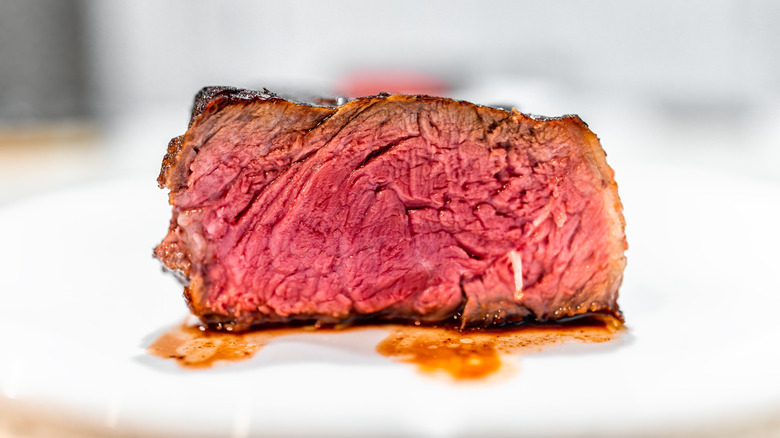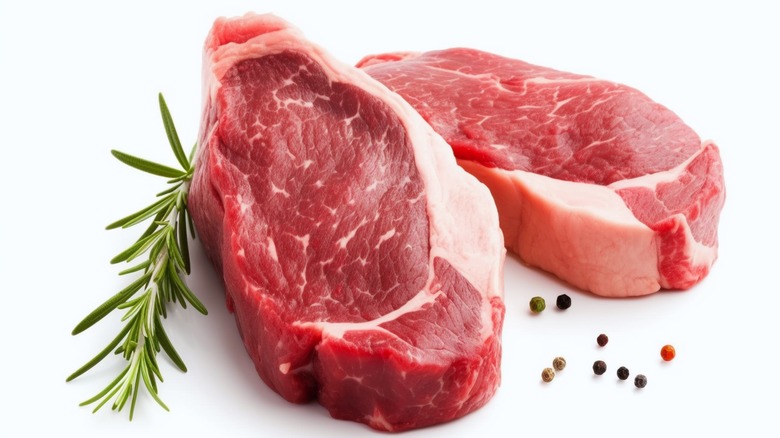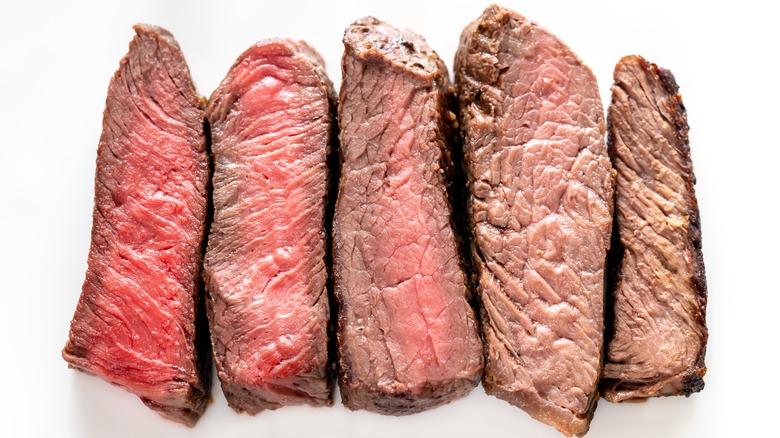What Makes Steak Juices Red, If Not Blood?
The presence of blood in food can draw pretty strong opinions. But, it's quite healthy (as long as it's not raw) as it contains high levels of protein, as well as essential vitamins, and minerals that our bodies need to function. It's not surprising then that blood factors into many cuisines — you'll find blood sausages around the world – except for one notable place: You won't find a drop of blood in American cuisine, and Americans, in general, are put off by even the thought of eating blood, even though it's perfectly fine to do so. At this point, you might be thinking, "hang on, doesn't steak have blood?" but you'd be wrong about that.
From the red puddle you often find at the bottom of raw beef packaging to the crimson juices that flow from a freshly grilled steak, it sure looks like it's bleeding. Rare steak lovers may even order their steaks "bloody," but this is one case where appearances are deceptive. Almost all the blood in the cow is drained upon slaughter. The juices you see are mostly water, which makes up about 75% of meat. The reason it's red is because the water mixes with a special protein called myoglobin, which plays a very important role in the art of cooking steak.
What does myoglobin do?
Myoglobin is found in mammalian muscles (including yours), where it stores the body's most vital form of fuel: oxygen. While myoglobin isn't part of blood, they do have an important connection. Blood contains a protein called hemoglobin, which binds to oxygen and carries it throughout the body. When blood reaches organs and muscles, the oxygen is transferred from hemoglobin to myoglobin. They perform the same function, except that one store's oxygen in blood, and the other stores oxygen in muscle. They also share another thing in common: the color red.
Myoglobin isn't blood, but it's red for the same reason that blood is. Both myoglobin and hemoglobin contain iron, which turns red when exposed to oxygen in the air. If you cut open a big piece of raw meat, you'll see that it's purple, but now that you've exposed the interior to the air, it will quickly change to red.
The more myoglobin in meat, the redder it will appear. That's why meat from poultry, whose bodies contain very little myoglobin, is light, while meat from cows, who have high levels of myoglobin, is dark red. After an animal is slaughtered, its muscle tissue begins to slowly break down, and after a while, water and myoglobin will start to leak out. They can also leak out when you break the muscle tissue when slicing into a steak.
The way steaks are treated affects how bloody they look
Steaks and their juices can be different colors, both when cooked and when raw, and that's all because of myoglobin. First off, the more a muscle has to work, the more myoglobin it needs, which is why a hardworking cut of beef, like the shank, will often be a darker red than filet mignon, which comes from a muscle that barely does any work. Furthermore, the older an animal is, the more myoglobin its meat will contain.
When you see packaged beef in stores that's sitting in a puddle of red, that's an indicator that the meat was probably frozen for transport. Freezing causes the water in meat to form ice crystals, which slash muscle cells apart so that when the meat is eventually defrosted, a large amount of juice can leak out. Raw meat also turns brown the longer it sits around, and that's because the iron in myoglobin is oxidizing, similar to the way it does in a rusty cast iron skillet.
Myoglobin is also the reason that steak becomes less red the longer you cook it. For starters, prolonged exposure to heat causes the water within the muscle to evaporate, carrying some of the myoglobin with it. Furthermore, once a steak passes medium doneness, the myoglobin undergoes a series of chemical reactions that eventually turn it into metmyoglobin, which makes meat grey instead of red. At that point, your steak probably won't have any juices left.


